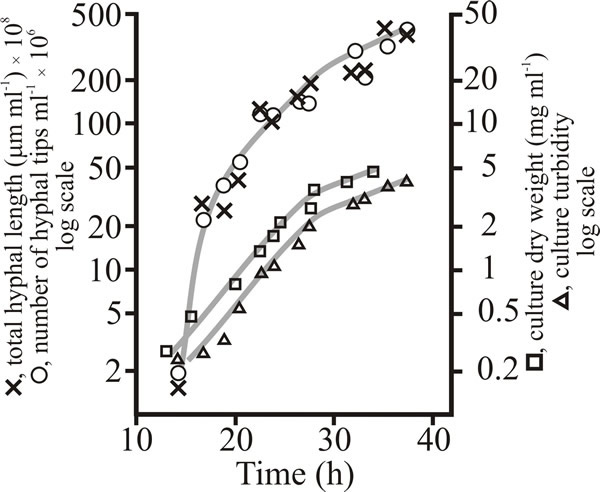17.7 Growth yield
The final yield of the culture can be determined when it enters the stationary phase. The yield (X) of a culture is the difference between the initial biomass (X0) and the maximum biomass at the end of the growth phase (Xmax):
![]()
The yield can be related to the amount of substrate used (an important consideration in commercial cultures where you have to ask how much product you are getting from the expensive substrate you are adding). This is the yield coefficient (Y), which is the ratio of the biomass formed (measured in g) to the mass of substrate (e.g. glucose) consumed (S, also in g):
![]()
Because of the morphological difference between unicellular bacteria or yeasts and apically-elongating, non-fragmenting, hyphal fungi, culture absorbance is a less reliable way of assessing the biomass of filamentous fungi than of bacteria or yeasts. Nevertheless, it is non-destructive and useful method for most growth experiments with fungi.
Fig. 14 shows early growth of the ascomycete Geotrichum candidum in shake flask batch cultures; that is, cultures in a defined starting volume of liquid medium that were incubated on a shaking platform in a constant-temperature room. The parameters plotted introduce a number of features. Note that biomass was quantified both by measuring culture absorbance (or ‘turbidity’; open triangles in Fig. 14) and by subsequently drying the sample to determine dry weight (open circles in Fig. 14). The numerical values of these two measurements are obviously different, but the patterns of the curves that result are sufficiently similar for turbidity to be used as a reliable measure of biomass in such cultures of this organism.
 |
|---|
| Fig. 14. Initial growth of the ascomycete Geotrichum candidum in shake flask batch cultures. The plots show the increase in dry weight (open square; mg ml-1, log scale), culture tubidity/absorbance (open triangle, log scale), total hyphal length (cross; μm ml-1 × 108, log scale) and number of hyphal tips ml-1 × 106 (open circle, log scale) of Geotrichum candidum in shake flask culture. |
The other parameters recorded in Fig. 14 introduce the features that are characteristic of the filamentous growth form of such cultures; namely, total hyphal length (× symbols in Fig. 14) and number of hyphal tips (open squares in Fig. 14) of the biomass; note that these plots also closely follow the form of the dry weight (biomass) growth curve. Again, and as expected, the numerical values represented by these different measurements are different but the curves described by the observations are so similar as to be reasonably judged identical. Consequently, these observations show that:
- increase in culture dry weight is a reliable measure of increase in total hyphal length;
- culture absorbance is a reliable (but non-destructive) measure of culture dry weight;
- increase in culture absorbance is a reliable measure of increase in the total number of hyphal tips in the culture.
Of course, having measurements of both total hyphal length and number of hyphal tips allows the former to be divided by the latter to calculate the length of the hyphal growth unit (G) (Table 6).
Table 6. Hyphal growth unit
length of Geotrichum candidum in agar and liquid media |
||
|---|---|---|
| Type of medium | Temperature (°C) |
Hyphal growth unit length (G, μm) |
Liquid |
20 |
112 |
Agar |
25 |
110 |
Updated July, 2019
